Using $10,000 to earn $1 million through cryptocurrency trading in one year is only possible with one method: rolling positions + holding onto big altcoins!
I have personally tested this method; in five months in 2025, I turned $10,000 into over $1 million, nearly multiplying it by over 100 times!
If you also want to share in the cryptocurrency market, take a few minutes to read this article, and you are just one step away from a million!
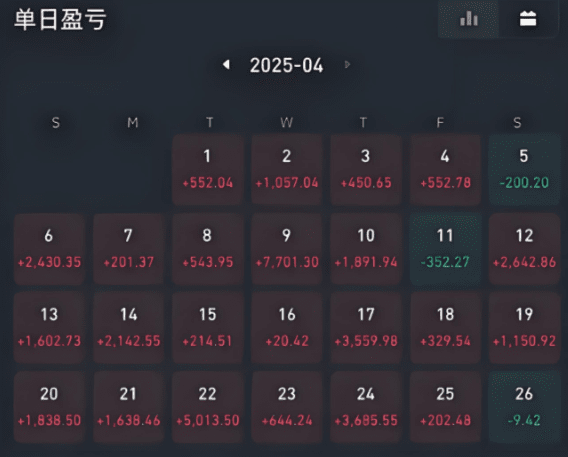
Bitcoin trading, using a one-for-ten rolling position method.
There is a very realistic issue in trading:
1. If someone has $100,000 in principal, a 10% increase in price means a profit of $10,000.
2. If you have $10,000 in principal, only doubling can profit you $10,000.
Is it easier for the market to grow by 10% or to double?
For personal operations, is it easier to capture 10% of the market movement or to capture a doubling market?
Even someone who has never traded can see this answer is obvious.
However, if you only have $10,000 in principal, how can you quickly grow your principal? Is there a method?
In this world, many fast tracks are designed for the brave; if you dare to take the risk, there are many paths available.
The pyramid trading method or rolling positions is an operational technique that exponentially amplifies benefits; while others might achieve two to three times, you can achieve six to seven times.
Rolling positions are suitable for trending markets, specifically during larger single-direction market movements.
The essence of rolling positions: give up current profits and reinvest them into trading; control risks by moving the stop loss.
Cryptocurrency market secrets of rolling positions: how to steadily profit, avoid risks, and achieve rolling position doubling.
1. Rolling positions timing
2. Technical analysis
3. Position management
4. Adjusting positions
5. Risk management
Investors preparing to enter the cryptocurrency market must realize clearly that it is not a place where one can easily achieve the dream of getting rich overnight. On the contrary, it requires investors to conduct long-term market research, accumulate experience, and engage in continuous learning. Many enter the market with fantasies of quick wealth, hoping to achieve huge returns from small investments. Although such success stories do exist, they often require carefully planned 'rolling positions' strategies, which are not easily accomplished nor achievable through frequent operations.
The 'rolling positions' strategy is theoretically feasible; it requires investors to invest at appropriate positions when major market opportunities arise, rather than frequently making small trades. The successful implementation of this strategy often relies on accurate market trend judgments and timing grasping. Though capturing a few such opportunities in a lifetime could lead to wealth accumulation from zero to millions, this requires investors to possess high market insight and decision-making capabilities.
In the pursuit of profit, investors should not focus solely on the final profit target but should pay more attention to how to achieve those targets. This means starting from their actual situation, investing time and energy to deeply understand the market, rather than blindly pursuing unrealistic huge profits. The essence of trading lies in identifying and seizing opportunities, rather than blindly pursuing light or heavy positions.
Rolling positions timing
Rolling positions require the right timing, location, and human factors to increase the odds of winning. Here are four golden opportunities for rolling positions:
Breakthrough after long-term consolidation: when the market has been in a sideways state for a long time, and volatility has dropped to a new low, once the market chooses a breakthrough direction, consider using rolling positions.
Bottom-fishing in a major drop during a bull market: during the wave of a bull market, the market experiences a strong rise and then suddenly drops. At this time, consider using the rolling position strategy to seize bottom-fishing opportunities.
Weekly level breakthrough: when the market breaks through a key resistance or support level on the weekly chart, it is like breaking through a solid defensive line. At this time, rolling positions can seize this breakthrough opportunity.
Market sentiment and news events: when market sentiment is as changeable as the weather, or there are major news events and policy changes that may shake the market, rolling positions can become your weapon.
Only under these specific circumstances will the odds of rolling positions significantly increase. At other times, it is best to remain cautious or simply abandon unclear opportunities. However, if market conditions seem suitable for rolling positions, do not forget to strictly control risks and set stop-loss points to prevent accidents. After all, wise investors are those who understand how to find a balance between risk and opportunity.
Technical analysis
After confirming that the market is suitable for rolling positions, the next step is technical analysis. First look at the trend, using moving averages, MACD, RSI, and other tools to determine whether the market is moving up or down. If possible, it is best to use multiple indicators together for more reliability.
Identify key support and resistance points in the market, assess whether the breakout is reliable, and use divergence signals to capture reversal opportunities. For example, if the price reaches a new high but the MACD does not follow suit, this may indicate a top divergence, suggesting that the price may fall, at which point you can consider reducing positions or shorting. Conversely, if the price reaches a new low but the MACD does not reach a new low, this may indicate a bottom divergence, suggesting that the price may rise, at which point you can consider adding positions or going long.
Position management
Reasonable position management hinges on three steps: determining initial position, setting adding rules, and formulating reduction strategies. For example, this makes it easier to understand.
Initial position: if you have $1 million, the initial investment amount should not exceed 10%, that is, $100,000.
Position adding rules: when you decide to increase investment, you must wait until the price breaks through the key resistance level; the amount added each time should not exceed 50% of the original investment, meaning a maximum addition of $50,000.
Reduction strategy: when the price reaches your expected profit target, you can start to sell gradually. Remember to let go when it's time to let go, do not hesitate. Each selling amount should not exceed 30% of the current holding amount, so you can gradually lock in your profits. In fact, as ordinary investors, we can be bolder when we encounter great opportunities, and be more conservative when opportunities are few.
With good luck, you might earn a few million; with bad luck, you can only accept reality. However, I must remind everyone, once you make money, you should first withdraw the invested principal, and then use the profit portion to continue investing. You might not make money, but you cannot lose money.
Adjusting positions
Arriving at the most critical step—how to achieve rolling positions through adjusting holdings.
1. Timing: enter the market when the conditions for rolling positions are met.
2. Opening positions: follow the signals of technical analysis, find the right timing to enter.
3. Adding positions: if the market moves in your direction, gradually add to your position.
4. Reducing positions: when you have earned the expected profit, or if the market seems a bit off, gradually sell.
5. Close positions: when you reach your target price or the market clearly indicates a change, then sell all. I will share how to operate specifically: (1) earn money before adding more: if your investment rises, consider adding more, but the precondition is that the cost has come down, and the risk has decreased. Not every time you earn should you add more.
Risk management
In simple terms, it involves two aspects: total position control and capital allocation. Ensure that your total investment does not exceed the risk you can bear, and capital allocation should be wise; do not put all your eggs in one basket. Additionally, always pay attention to market dynamics and technical indicator changes, flexibly adjust strategies based on market conditions, and timely stop losses or adjust investment amounts when necessary. Many people may feel excited and fearful when they hear about rolling positions, eager to try but worried about risks. In fact, the risk of the rolling positions strategy itself is not high; the key is in the use of leverage. If used wisely, risks can be fully controlled. For instance, if I have $10,000 in principal and open a position when a certain coin is priced at $1,000, I use 10x leverage but only use 10% of the total fund (i.e., $1,000)

Common questions and answers about rolling positions.
Is rolling positions suitable for beginners?
The risk of the rolling positions strategy is relatively high; it is recommended that beginners start with low leverage and stable trend trading to accumulate experience before considering using rolling positions.
How to determine the timing for adding positions?
The timing for adding positions usually occurs after the trend breaks through key points or rebounds to support levels. Technical indicators such as moving averages, MACD, convergent triangles, etc., are used to help judge.
How to operate in a sideways market?
Rolling positions are not suitable for sideways markets; in such cases, operations should be reduced, and patience should be exercised while waiting for a trend to emerge.
Can you directly roll positions when opening a position?
Whether or not to directly roll positions when opening a position, or whether to wait until the position is profitable before using the profit portion to add positions, depends on your trading strategy and market conditions. The core concept of rolling positions is to continuously amplify positions within a trending market, using floating profits to increase positions for compound growth. Therefore, typically, rolling positions are carried out on the basis of existing profits, allowing the profits already earned in the market to bear the risks of new positions and reduce personal capital risk exposure.
Here are two common ways to operate rolling positions:
Open positions and roll positions after confirming the trend: after confirming that the trend is established, open positions to establish holdings, and then gradually expand the positions through rolling positions as the trend develops. This method leverages the power of the trend, rolling positions through floating profits, aiming for higher returns. A typical practice is to open positions after the market breaks through key levels and then gradually add positions when there are profits. The risk at this time is lower because the subsequent added positions are funded by profit.
When opening positions, can you directly roll positions, or do you need to wait until the position is profitable before using the profit portion to add positions? This depends on your trading strategy and market conditions. The core idea of rolling positions is to continuously expand positions in a trending market, using floating profits to increase positions for compound growth. Therefore, usually, rolling positions are conducted on the basis of existing profits, allowing already earned market profits to undertake the risks of new positions, thus reducing personal capital risk exposure.
Cryptocurrency rolling position method and daily line watching knowledge.
In the cryptocurrency market, you need to find a way to first earn $1 million in principal. From several thousand to earn $1 million in principal, there is only one path: rolling positions!
Operation steps (taking Bitcoin as an example)
1. Initial position opening
Position ratio: initial opening should not exceed 10% of total capital (for example, with $10,000 capital, the initial opening should be $1,000). Leverage + selection: it is recommended to use 2-3 times leverage, avoiding high leverage risks. Stop loss + settings: strictly set 2%-3% stop losses (e.g., opening price $10,000, stop loss price $9,800), ensuring that single losses do not exceed 2% of total capital.
2. Profit-taking and adding positions in batches +
Position adding conditions: price rises by 5% or 10% (adjust based on trend strength), and the trend is not broken; adding ratio: each addition amount is 30% to 50% of current total profits (for example, first position profits $2,000, add $600 to $1,000).
Dynamic stop loss: after each addition, move the overall stop loss up to the breakeven point (e.g., initial position cost $10,000, after adding, cost $10,500, adjust stop loss to $10,500).
3. Profit-taking and exit
Trend continuation: if the trend persists, continue to add positions proportionally until reaching the target profit (e.g., total funds doubling) - profit-taking signal: when a clear top formation appears (like a long upper shadow, shrinking volume), or when breaking below the trend line or key support level, take partial profits.
Key points
1. Only roll long positions: avoid counter-trend operations; the bull market cycle in the cryptocurrency market is longer, and upward trends are easier to capture.
2. Isolated position mode: using the exchange's 'isolated margin + ' mode to isolate single position risks and avoid total liquidation.
3. Leverage restriction: even if the trend is clear, leverage should not exceed 5 times to avoid extreme fluctuations leading to liquidation.
4. Emotional management: do not chase high prices after missing the opportunity to add positions; wait for a pullback or the next trend signal.
Case demonstration (rolling positions with $50,000 principal)
1. Initial position opening: $50,000 principal, first investment of $5,000, 3x leverage to long Bitcoin (opening price $30,000)
2. First profit: Bitcoin rises to $33,000 (+10%), earning $3,000. Add $3,000 (total position $8,000). 3. Second profit: Bitcoin rises to $36,000 (+20%), total profit $6,000. Add $3,000 (total position $11,000).
4. Trend continuation: repeat adding positions until the target price (e.g., $40,000), with potential profits reaching 2-3 times the principal.
My cryptocurrency trading method is very simple and practical; I made it to eight figures in just one year, only entering the market when I see the opportunity, not trading without patterns, and maintaining a win rate of over 90% for five years!

I am Awen, having experienced multiple bull and bear cycles, with rich market experience in various financial fields. Follow (Awen Talks Coins) here, penetrating the fog of information, discovering the real market. Grasp more wealth password opportunities, discover truly valuable opportunities, and don’t miss out on regrets!
Understanding trends in the crypto market, mastering effective support and resistance positions.
1. What is a trend (a term in finance):
A trend is the direction of the market's movement, either upward, downward, or sideways. Trends are regular conclusions drawn from observing financial trading markets (such as stocks, futures, forex, cryptocurrency, etc.); changes in buy and sell decisions shape the different forms of trends. Trends always move in the direction of the least market resistance; finding a trend is also about finding the direction of least resistance. Trading masters generally advocate that traders follow the trend.
According to Dow Theory: any trend will eventually complete its course, meaning a bull market must be accompanied by a bear market, repeating in cycles. Market prices do not rise straight up in one direction; the trajectory of trend movements resembles waves following one after another, with clear peaks and troughs.
Peaks and troughs are the basic elements that constitute different trends. Based on the positions of peaks and troughs, they can be divided into: upward trend, downward trend, and sideways trend.
1. Upward trend:
Judgment basis: both peaks and troughs gradually rise.

2. Downward trend:
Judgment basis: both peaks and troughs gradually decrease.
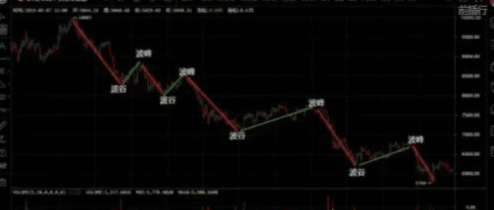
3. Sideways trend:
Judgment basis: peaks do not increase regularly, and troughs do not decrease regularly. Peaks and troughs do not have a clear rising or falling pattern. Under special circumstances, peaks and troughs can be on the same level.
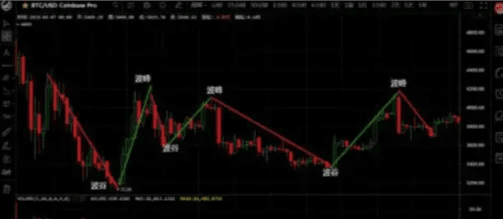
Three types of trends: major trends, secondary trends, and short-term trends (Dow Theory).
① Major trends: represent the overall basic trend, indicating the comprehensive rise or fall of market prices, with the longest time span and significant price changes. The formation of major trends often requires a longer time and more capital battles. As long as the next rise exceeds the previous high and the next drop exceeds the previous low, the overall trend is upward, indicating a bull market. Conversely, if the overall trend is downward, it is called a bear market. Trends exhibited in large cycles, such as daily and weekly lines, are less likely to be manipulated by speculators.
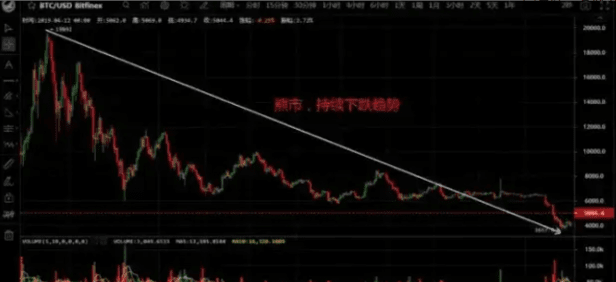

② Secondary trends: occur within the primary trend, playing an adjusting role for market price fluctuations, also known as corrective trends.
If the primary trend is a bull market, then the secondary trend is the downward pullback during the upward process. If the primary trend is a bear market, then the secondary trend is the upward rebound during the downward process. The adjustment amplitude of the secondary trend is generally between one-third and one-half of the primary trend.
③ Short-term trends: fluctuations within a day or smaller cycles, which are components of secondary trends; short-term fluctuations themselves are meaningless, so analyzing major trends using short-term fluctuations can easily lead to erroneous conclusions. Short-term trends last for a short time, are easily manipulated, and are not recommended for ordinary investors to trade.
----------------------
The major trend consists of minor trends, and minor trends often follow the major trend. When a trend reverses, minor trends are more sensitive than major trends. In any market, these three types of trends must coexist. Any trend will eventually complete its course, meaning a bull market must be accompanied by a bear market, repeating in cycles.
Long-term traders are most concerned with major trends: daily, weekly, monthly, etc. Short-term investors care about secondary trends and short-term trends.
Choose the type of trend that suits your type of investor.
How to draw trend lines:
Trend lines can visually indicate the trend direction. They are used to predict future market changes and assess support and pressure. The support or pressure effect of a trend line will eventually be broken, leading to changes in price direction.
1. What is a trend line? 2. How to draw a trend line? 3. The role and precautions of trend lines.
Conditions for trend reversal:
1. During the upward process, if the pullback low is lower than the previous low, the upward trend line ends. As shown, point D is lower than point C.
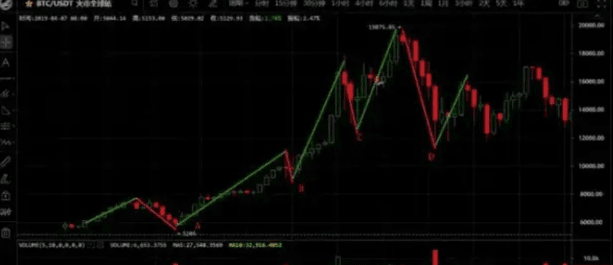
2. In a downtrend, the rebound peak is higher than the most recent downtrend starting point, indicating the end of the downtrend. As shown:

Judging trends, trading in accordance with the trend:
Judging trends, divided into major trends and minor trends. Major trends refer to whether it is a bear or bull market, while minor trends refer to whether short-term prices are declining or rebounding. If the major trend is likely at the bottom and in a sideways position, and the short-term trend shows minor oscillations, you can consider buying at support.
If BTC's bottom gradually rises and operates above various moving averages, with multiple indicators showing an upward trend.
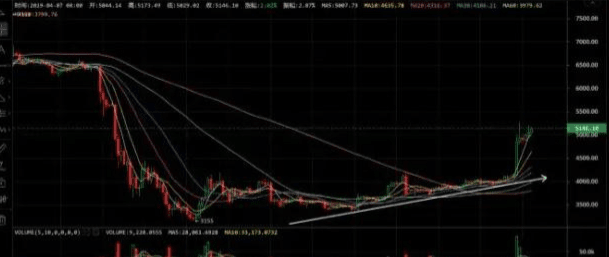
In addition to the above methods for analyzing and judging trends, various technical indicators such as candlesticks, volume, and moving averages should also be used as references.
Trend indicators also include: MA moving averages, BOLL indicators, MACD, Fibonacci retracements, etc.
These are the historical experiences left by the long evolution of financial markets, and they are successful historical experiences. Behind them lies knowledge of mathematics, psychology, and more. Technical analysis is not guessing or divining the future; it is a summary and speculation on changes in the trading market obtained through long-term statistics, observations, and verifications by investment masters.
I often mention rolling positions. In my view, rolling positions are the most stable strategy for contracts, almost ensuring that the position is absolutely safe. Someone asked how to play rolling positions?
I will share my methods:
Upward wave trend: go long, position size should not exceed one-third of the bullets.
1/3. High selling and low buying; whenever approaching a pressure point, take profit 1/3, and add 1/3 when it pulls back. You can preemptively set profit-taking near the upper two pressure points to prevent sudden spikes and drops, maximizing part of your profit. Keep a tail position until the high point of the shock phase is reached and stop loss is set.
Downward wave trend: go short, position size should not exceed one-third of the bullets. Whenever approaching a support point, take profit 1/3, and add shorts on rebounds.
1/3. You can preemptively set profit-taking near the two support levels below to prevent sudden accelerated declines and maximize profits. Keep a tail position until the low point of the shock phase is reached and stop loss is set.
Hedging: simultaneously operate low long and high short, which requires a specific timing, specifically when the K-line reaches a triangular consolidation area, continuously oscillating for more than one to two weeks without breaking through; this type of market is suitable for long-short hedging. Generally not applicable.

Having been in the cryptocurrency market for over ten years, I believe I have outperformed 90% of contract traders in the market. I have experienced capital pools, contracts, and arbitrage, and have also been ruthlessly harvested by speculators. Having experienced the pitfalls that the market has to offer, how can one survive long-term in the market? To achieve success and long-term survival in the market,
You can follow these key strategies:
1. Risk management
Use spare money for investment, avoid using high leverage or loans.
Set stop-loss points; once the preset loss limit is reached, sell decisively to avoid further losses.
2. Investment strategy
Diversified investment: do not put all funds into one project, but rather spread investments across different coins and projects to reduce risk. Long-term holding: for quality projects, hold for a longer time to utilize the compound interest effect for wealth growth. Timely selling: at market peaks, if there are significant negative news, it might be a good time to sell.
3. Information acquisition and processing
Establish your own information sources, such as CoinMarketCap+, Defllama+, etc., to obtain accurate market data.
Learn to distinguish the truth from false information, avoiding being misled by inaccurate information.
4. Psychological adjustment
Stay calm and not be influenced by short-term market fluctuations.
Set reasonable expectations, avoid overtrading and frequent operations.
5. Continuous learning
Regularly study blockchain technology and knowledge related to digital currencies, keep up with industry developments, participate in community discussions, and exchange experiences with other investors to broaden your horizons.
6. Balance between life and investment
Ensure that investment activities do not interfere with daily life and health.
Maintaining physical and mental health helps better cope with challenges during the investment process.
I am the Chief Instructor, having experienced multiple bull and bear cycles, with rich market experience in various financial fields. Follow (Awen Talks Coins) here, penetrating the fog of information and discovering the real market. Grasp more wealth password opportunities, discover truly valuable opportunities, and don’t miss out on regrets!


